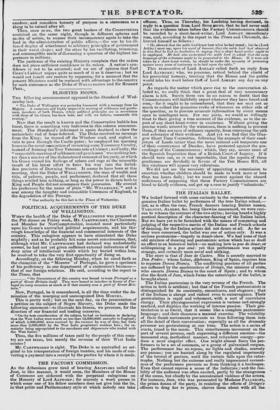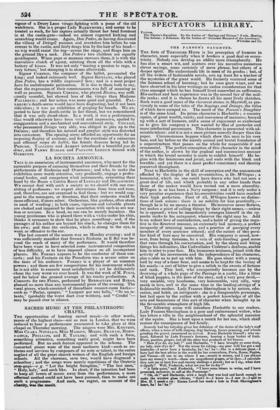THE ITALIAN BALLET.
WE looked forward with some curiosity to the representation of a genuine Italian ballet by performers of the true Italian school,—
not, as is often the case, French dancers bearing Italian names..
TAGLIONI, ALBERT, &c. being likewise announced, we were curious to witness the contrast of the two styles;. having heard a highly poetical description of the character-dancing of the Italian ballet.. But we have yet to be furnished with the means of comparing and judging of the respective merits of the Italian and French schools of dancing, for the Italian artists did not dance at all. As far as they were concerned, the ballet was one of action only. It was a, serious pantomime—tragedy in dumb-show. We had none of that odd. mixture of dancing and pantomimic action which has so droll an effect in an historical ballet—no making love in pas de deux, or' soliloquizing in a pas seal: yet this performance was equally strange, and certainly more novel and striking.
The story is that of Inez de Castro. She is secretly married to. Don Pedro ; whose father, Alphonse, King of Spain, requires him to espouse Donna Bianca. The conflicting passions of all parties are inflamed by the machinations of Driego, the minister of state,. who escorts Donna Bianca to the court of Spain ; and by whom also the death of /nen, which forms the catastrophe of the ballet, is brought about.
The Italian pantomime is the very reverse of the French. The action in both is artificial ; but that of the French pantomimists is distinguished for its continuity, smoothness, and elegance ; that of the Italians is abrupt and violent even to extravagance. Their gesticulation is rapid and vehement, with a sort of convulsive energy. Their physiognomical expression is various and strongly marked, and displays the working of intense passion. Their gesticulation is so literal, that it seems like a complete pantomimic language; and their discourse a manual exercise. The volubility
of their dumb movements prevents us from following them into all the detail of their conversation; especially as all the dramatis personce are gesticulating at one time. The action is a series of
starts, timed to the music. This simultaneous movement on the part of several persons, well expressing a different emotion—the
measured step, methodical manner, and redundant energy—produce a most singular effect. One might almost fancy the performers to be a set of automata, or a group of galvanized corpses. The performance has no repose, no lights and shades, scarcely any pauses; you are hurried along by the regulated impetuosity of the torrent of gesture, until the curtain falls upon the catastrophe. Nothing but the extreme and really impassioned earnestness of the performers prevents us from thinking it a burlesque.. Even that cannot repress a sense of the ludierins ansh the risibility of the audience was often excited, partly by the strangeness of the scene, but chiefly by the unrestrained violence of the actors For instance, Inez, who was personated by Madame PALLERINI, the prima donna of the party, in resisting the efforts of Driego's officers to drag her to prison, shoves them about with all the. vigour of a Drury Lane virago fighting with a posse of the old watchmen. She is a proper Lady BARRYMORE ; and seems to be treated as such, for her captors actually thrust her head foremost in at the castle-gate—indeed we almost expected kicking and scratching would ensue. Again, Don Pedro, on having discovered the villany of Driego;'• pursues and overtakes him before he can retreat to the castle, and fairly drags him by the hair of his head— no wig would resist the tug—across the stage, and flings him on the ground like a sack. Don Pedro's two children are equally gestiloquent. When papa or mamma caresses them, it is with the convulsive clutch of agony, saluting them all the while with a battery of kisses. It was not only "tearing a passion to rags, to very tatters," but stamping it to atoms afterwards. Signor CORTES', the composer of the ballet, personated the king; and looked extremely well. Signor HONE &NI, who played Don Pedro, has a wildly expressiva face ; and is a most proper hero for melodramatic pantomime. It is due to them both to say, that the expression of their countenances was full of meaning as well as passion. Signora CORTESI, who played Bianca, was suffie:iently scornful, but showed less of the virago than Madame PALLERINI ; and her action was more quiet and graceful. PAL,LERINI'S death-scene would have been disgusting, had it not been ridiculous ; it was an exhibition of gasping for breath. We ex-pected to hear the death-rattle in her throat, but we remembered that it was only dumb-show. In a word, it was a performance, 'that would otherwise have been vivid and impressive, spoiled by 'exaggeration and a mechanical and conventional style. COULON, who personated Driego very ably, was obliged to play up to the Italians-; and therefore his natural and graphic style was distorted into caricature. The opening scene afforded an opportunity for an imposing display of costume, and for the exertions of a numerous and efficient corps de ballet, the female dancers being led by PROC HE. TAGLIONI and ALBERT introduced a beautiful pas de deux, and FANNY ELSLER and PAULINE LEROUX danced with GUERI NOT.



















 Previous page
Previous page